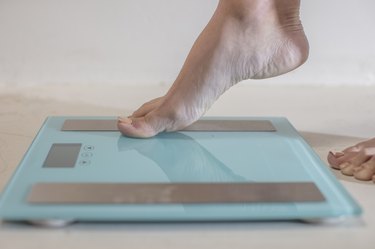
Prediabetes is when your blood sugar levels are high, but not high enough to be considered type 2 diabetes.
"It's sort of an in-between condition," says Sue Kirkman, MD, professor of medicine in the division of endocrinology and metabolism at UNC Health. "It's considered a precursor to type 2 diabetes."
Breaking Down Prediabetes
Fasting blood sugar levels that are consistently between 100 and 127 mg/dL are considered prediabetes, according to the American College of Cardiology. Normal is between 70 and 100 mg/dL, and multiple readings above 127 is considered type 2 diabetes.
About one-third of Americans have prediabetes, according to the Centers for Disease Control and Prevention (CDC), although the majority don't know it.
People who have been diagnosed with the condition have a 50 percent chance of moving on to full-blown type 2 diabetes within the next five to 10 years, according to the National Institute for Diabetes and Digestive and Kidney Diseases (NIDDK).
"If changes aren't made in eating habits and activity, many people with prediabetes will move into the diabetes category," Julie Stefanski, RDN, a dietitian, certified diabetes instructor and spokesperson for the Academy of Nutrition & Dietetics, tells LIVESTRONG.com.
Even if you don't develop diabetes, though, having prediabetes can up your risk of heart and kidney disease, per the Mayo Clinic.
If you know you have prediabetes, you have the opportunity to take measures to get your blood sugar levels down to a healthy range and prevent the condition from progressing.
Causes of Prediabetes

The biological causes of prediabetes (and diabetes) have to do with insulin resistance.
Insulin is the hormone that guides blood sugar molecules (broken down from the food you eat) out of the bloodstream and into cells, where they're used as fuel. In prediabetes and diabetes, your body either loses the ability to respond properly to insulin or doesn't make enough insulin, which means the sugar levels in your blood build up.
"As prediabetes develops, the body struggles more and more to process certain foods," Stefanski explains. "The pancreas must make higher levels of insulin to take sugar out of the blood and put it into the cells of the body. Eventually the body won't be able to keep up with insulin needs and blood sugar levels will rise."
No one really knows what causes insulin resistance in the first place, though it seems to be a combination of factors.
"The risk factors for prediabetes are the same as risk factors for type 2 diabetes," Dr. Kirkman says. According to the Mayo Clinic, those include:
- Family history and genetics: If you have a parent or sibling with type 2 diabetes, you're more likely to develop prediabetes (and type 2 diabetes).
- Age: The risk of developing prediabetes rises after the age of 45.
- Having overweight or obesity: The risk is even greater if fat is concentrated around the abdomen.
- Waist size: Men with waists larger than 40 inches around and women who have waist circumferences larger than 35 inches are at a higher risk for insulin resistance, even if their body mass index (BMI) is normal, according to the NIDDK.
- Being inactive: Regular exercise is key to reaching and maintaining a healthy weight and helps your body better process sugar and use insulin.
- Diet: Red and processed meat along with sugary beverages increase the risk of prediabetes. Eating more fruits, vegetables, whole grains, olive oil and nuts is linked to a lower risk.
- Gestational diabetes: Women with a history of this pregnancy condition are at higher risk for prediabetes and type 2.
- Race and ethnicity: African Americans, Hispanics, Native Americans, Asian Americans and Pacific Islanders have a higher risk than other groups.
- Polycystic ovary syndrome: This hormonal disorder in women, commonly referred to as PCOS, is marked by small cysts on the ovaries, according to the Mayo Clinic.
- Metabolic syndrome: This condition is marked by high blood pressure combined with abnormal cholesterol levels and a large waist size, per the NIDDK.
- Other risk factors: Obstructive sleep apnea and smoking may increase insulin resistance. Certain medications and hormonal disorders can also put you at higher risk.
Related Reading
Symptoms of Prediabetes

Like the early stages of diabetes, prediabetes usually doesn't have any symptoms at all. That's why about 90 percent of people with the condition don't even know they have it, Dr. Kirkman says.
Some people may have warning signs, which could include:
- Acanthosis nigricans, which are patches of dark, velvety skin. "These can appear on the neck, in the armpits or groin and indicate that the body is struggling to metabolize foods and beverages that raise blood sugar," Stefanski says. Skin tags may appear in the same areas, according to the NIDDK.
- Feeling extra thirsty even though you're drinking a lot of water, per the Mayo Clinic.
- Urinating frequently.
- Feeling hungry all the time, even though you're eating a healthy amount.
- Fatigue.
- Blurred vision is also sometimes a sign, according to the CDC.
Diagnosing Prediabetes
Because prediabetes usually doesn't have any symptoms, "it's important to get screening tests if you have risk factors," Dr. Kirkman says.
The American Diabetes Association (ADA) recommends testing be considered in adults who have no symptoms but have a BMI of 25 or higher (23 or higher in Asian Americans) and one or more other risk factors.
Testing should begin for all people starting at age 45. If your results are normal, you don't have to be re-tested for three years, Dr. Kirkman says.
The same three tests that can diagnose diabetes are also used to diagnose prediabetes, according to the Endocrine Society. They are:
- Fasting blood glucose test (FBG): This is a blood test that takes place after you've been fasting for eight hours (usually overnight) and drinking only water. Prediabetes is when your fasting blood sugar is between 100 and 125 mg/dL, says Dr. Kirkman.
- Hemoglobin A1c test (HbA1C): This test measures your blood sugar levels over the past three months. Prediabetes is indicated when your numbers are between 5.75 and 6.4 percent, says Dr. Kirkman.
- Oral glucose tolerance test (OGTT): This test is rarely used, says Dr. Kirkman. That's partly because it's difficult to do. You have to have blood drawn two hours before and after drinking a sugary beverage, all after eight hours of fasting. A result over 140 means you are prediabetic, while over 200 indicates diabetes, per the NIDDK.
Typically, doctors will repeat the tests before giving a diagnosis of diabetes or prediabetes, says Dr. Kirkman.
Treating Prediabetes

Treating prediabetes really means preventing type 2 diabetes, and the sooner you get started the better. The American Academy of Family Physicians (AAFP) notes that the longer you have either condition, the higher the likelihood you'll end up with health complications.
"The main goal is to not advance to the point where you have type 2 diabetes," Dr. Kirkman says. "The treatments are primarily losing weight and exercising or certain medication."
1. Losing Weight
If you have overweight, losing just 5 to 7 percent of your body weight (or 10 to 14 pounds for a 200-pound person) can lower your risk for type 2 diabetes, according to the NIDDK. This will help push your blood pressure and cholesterol levels into healthy ranges, per the AAFP, and most importantly, adds Dr. Kirkman, "some people with weight loss will actually revert to having normal blood sugar."
There's debate about whether you can actually "reverse" prediabetes or even type 2 diabetes but, says Dr. Kirkman, with proper lifestyle changes, you can prevent or indefinitely delay progression.
Related Reading
2. Changing Your Diet
The best way to lose weight is through diet and exercise, each of which bring their own benefits to the table.
When it comes to diet, there's no one right way to eat if you have prediabetes. One place to start, though, is in the timing of your meals.
"Start by cutting back on the portions of foods you're eating at one time," Stefanski says. "Rather than eating the majority of your food during a few hours at night, spread those choices out more so that the body doesn't have to process everything at the same time."
You can also diminish portion sizes gradually, drink water rather than sweetened beverages and opt for whole fruit over fruit juice.
Green vegetables are a great way to feel full without raising your blood sugar, and the AAFP recommends eating more whole grains, lean proteins and low-fat dairy.
Foods to avoid include those that are processed, fried and sugary.
3. Adding More Exercise
"No matter what your weight, it's important to become more physically active," Stefankski says. "We've worked regular activity out of our daily lives. As humans, we need to move and stay active to keep processes within the body working appropriately."
The CDC recommends aiming for at least 150 minutes of moderate physical activity each week. Brisk walking is a good option, as are swimming and bike riding.
Related Reading
4. Getting Support
Research shows that people who get support are more likely to achieve their goals. Indeed, those with prediabetes who enacted changes encouraged by the National Diabetes Prevention Program (DPP), which includes a support component, lowered their risk of developing type 2 diabetes by as much as 58 percent.
5. Taking Medication
There's some controversy as to whether medications can or cannot help people with prediabetes. In one study, though, conducted as part of the DPP Outcomes Study, the medication metformin dropped the risk of developing type 2 diabetes by 31 percent. Ask your doctor if medication might be right for you.
Is this an emergency? If you are experiencing serious medical symptoms, please see the National Library of Medicine’s list of signs you need emergency medical attention or call 911.